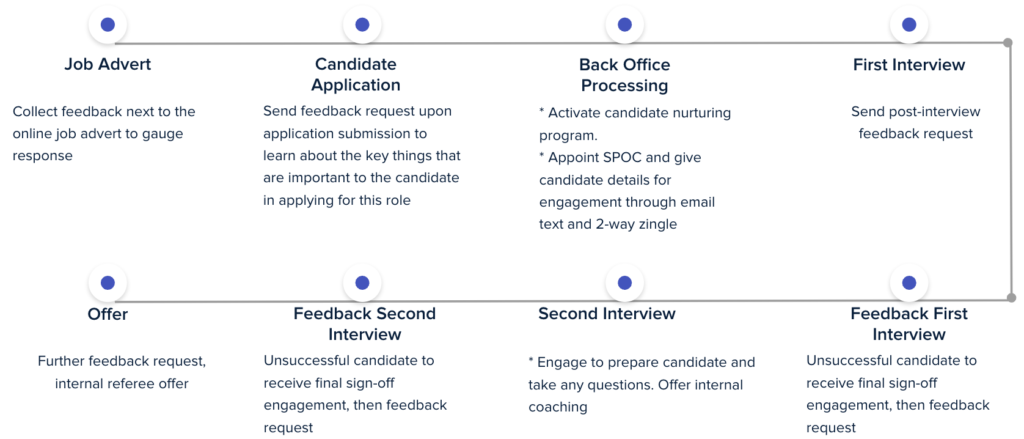In a tight labor market, it’s difficult for contact centers to attract candidates. Here are the factors at play and what talent acquisition teams can do to improve the candidate experience and solve the struggle to hire.
It’s already been an extraordinary year within the contact center. Last year, I predicted this would be the year we would start to see the cause and effect of attrition in contact centers as the return-to-office movement expedited some life-changing decisions for employees. Now that we are in 2022, we are seeing these predictions hold true.
Work-from-home (WFH) contact center agents are 57% more likely to recommend their employer (eNPS) than those working out of a physical call center, and WFH agents have an 80% better retention rate, according to a recent ICMI benchmark study on agent experience. While around 50% of agents are happy to work hybrid or remote, many employers want them to return to the office full-time. This is driving up resignations, as agents continue the search for more flexible work options. They are increasingly moving to businesses that both embrace the hybrid/remote work model and better compensation.
In this three-part blog series, we will uncover the three pain points making the greatest impact on contact center efforts to modernize and how to help solve them. This is the first pain point:
The Struggle to Hire Contact Center Agents
The number one challenge for contact centers has changed from high attrition and increasing workload to difficulty hiring.
According to HBR, five factors are contributing to today’s labor market. They call them the Five Rs: Retirement, Relocation, Reconsideration, Reshuffling, and Reluctance. Workers are retiring in greater numbers but aren’t relocating in large numbers; they’re reconsidering their work-life balance and care roles; they’re making localized switches among industries, or reshuffling, rather than exiting the labor market entirely; and, because of pandemic-related fears, they’re demonstrating a reluctance to return to in-person jobs.
So, given the enormity of what lies ahead, how can we use data to solve the struggle to hire and get ahead of this challenge?
Attract Candidates with More Engagement
A key solution in the struggle to hire is to first look at the hiring cycle and all the opportunities to engage with candidates during the recruitment process.
Start with asking candidates for feedback early on to learn what their expectations are. Remember that in order to attract the very best candidates, you need to know what’s important to them. This cohesive approach weeds out candidates who are not the right fit early in the process and empowers you to understand how best to promote the role to the market and get higher response rates.
Once the candidate is in the application pool, you can create an engagement lifecycle tracker that keeps the candidates informed as they move through the interview process, including information to help them prepare for their interviews. This way of engaging can help the candidate feel that the company wants them to succeed, creating engagement at a critical juncture in their hiring journey.
Implement Active Talent Management
The Medallia Contact Center Suite helps move the needle forward in the way recruitment works — companies move from a ‘let’s see what they can find out about us’ mentality to a proactively helpful one by sharing as much as possible with candidates and hiring managers so the interview feels familiar and the culture of the company can be ingrained quickly.
An easy-to-follow process in the recruitment stage should be paired with active talent management, where all engagement data is collected and analyzed. This process also includes ensuring the candidate has a single point of contact for their interview journey. Given this data, the business can have an accurate pulse of where the candidate is in their decision-making process and expedite hiring in areas where they are needed to significantly improve the hire rate.
In the example above, we can see that a short hiring cycle leaves an opportunity for candidate feedback at every stage of the process and has fully integrated creating a supportive culture. There is nothing wrong with coaching your candidates to be successful, as it makes them feel like you’re invested in their success and motivates them to bring their ‘A game’ to the interview process.
Improve the Candidate Experience for Your Contact Center
Reward potential is high for organizations who evolve their processes to empower the candidate and make the shift to stay engaged with them through the entire recruitment process. Collecting candidate feedback at all points of the recruiting journey increases the time spent from interview to offer by 30%, reduces the cost to interview by 33%, and increases candidate Net Promoter Score by 25 points for candidates with no offer.
Post engagement feedback surveys, omnichannel communication, and video feedback are just a few of the new and improved ways to capture candidate sentiment, no matter where they are on their journey.
The methods to stay engaged with your candidates during the hiring process have grown exponentially, and candidates expectations have followed suit. In this new world, contact centers now need to compete for candidates like they never had to before, which has resulted in hiring practices adapting to meet that challenge.
Interested in learning more about how to solve the struggle to hire contact center agents? Schedule a meeting to find out how your business can improve the candidate experience to attract more candidates and reduce costs to hire for your contact center.








